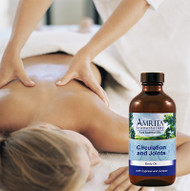Massages Using Aromatherapy Essential Oils
Apr 21st 2021
Posted by Stephanie Chambers
by Stephanie Chambers
The benefits of massage can be profound and even life-changing. Many people discover this after their first experience, walking away with a lightness and ease they had not felt before. In some cases, this sense of transformation can lead to a deeper interest in the practice itself.
Which Types of Massage Are Best?
With so many types of massage available today, choosing the right one can be challenging. One particularly profound type of massage, Maharishi Ayurveda, can even be combined with Shirodhara, in which warm oil is poured on the forehead, to get the ultimate full-body expirence. The sensation afterward was described as one of deep bliss, as though every cell in the body was radiating happiness.
In addition to professional treatments, self-massage using Abhyanga techniques can become a valuable daily practice. Long strokes are typically applied to the limbs, while circular motions are used around the joints. Beginning with the head and working down toward the feet, the process can be both invigorating and restorative when done regularly.
Which Oils Are Best for Massage?
Generally, sesame oil is used for Ayurvedic massages, as it is considered to be rejuvenating. For individuals with a Pitta dosha, medicated coconut oil is often applied due to its cooling properties. However, some may find that their skin still feels dry afterward. Ayurvedic physicians (Vaidyas) sometimes recommend olive oil for self-massage, depending on one's constitution and skin type. Ultimately, it is important to choose an oil that works best with your skin.
As described above, deeper and more long-lasting experiences tend to come with subtler levels of massage. By adding aromatherapy Essential Oils, their effects are felt both in terms of their smell but also because of their innate therapeutic qualities. So, you receive an effect from two senses at the same time – touch and smell.
Essential Oils have been used in Ayurvedic massage for centuries. That’s why the founder of Amrita Aromatherapy, Dr. Christoph Streicher, decided to receive training from Ayurvedic doctors when he was first creating Amrita Aromatherapy.
Essential Oils can be used to achieve various desired outcomes from massage. For example:
- To relieve stress: 5 drops of Neroli, 5 drops of Bergamot and 5 drops of Geranium can be mixed with a tablespoon of base massage oil like Almond oil (or you can use Amrita’s Unscented Body Oil as a base). Roman Chamomile can also be used to relieve stress. When combining oils, the total generally shouldn’t be more than 5 drops per tablespoon for an all body massage, although twice as many drops can be used of Roman Chamomile becauseit is very mild on the skin.*
- To relieve stiffness, inflammation or sore muscles: Lavender, Cypress, German Chamomile, Elemi or Eucalyptus Citriodora can diluted with carrier oil and be used individually or as a blend. These oils are warming and anti-inflammatory. See the “How To Use” section on each oil to determine how many drops per tablespoon to use. When combining oils, the total generally shouldn’t be more than 5 drops per tablespoon for an all body massage, although twice as many drops can be used of Lavender because it is very mild on the skin.*
- Sensual massage: 1 drop Jasmine, 1 drop Sandalwood, 1 drop Rose Geranium, 1 drop Ylang Ylang, and 1 drop Frankincense can be added per tablespoon of Almond oil. These oils relax, increase sensuality and open the heart.*
A small study 1 in 2005 showed that both normal massage (with Sweet Almond Oil) and aromatherapy massage (all-body massage with Sweet Almond Oil, and Lavender, Cypress and Sweet Marjoram Essential Oils and a foot bath with Tea Tree) decreased anxiety and depression, but only aromatherapy massage increased peripheral blood lymphocytes, indicating that the aromatherapy massage may have been of more benefit to the immune system. Most people find massage of benefit and aromatherapy massage even more enjoyable. So why not try giving yourself or your partner an aromatherapy massage, or ask your massage therapist to blend in an Essential Oil you would like to try with the oils they are going to use? See How To Apply Essential Oils for further details. You might be surprised by the effects.
Sources:
1 http://www.ncbi.nlm.nih.gov/pmc/articles/PMC1142199/
Disclaimer: *The statements made in this blog have not been evaluated by the U.S. Food and Drug Administration (FDA). They are not intended to diagnose, cure or prevent any disease. If a condition persists, please contact your physician or healthcare provider. The information provided is not a substitute for a face-to-face consultation with a healthcare provider, and should not be construed as medical advice.
Original Published: 2015-11-02 / Last Modified: 2025-6-5

